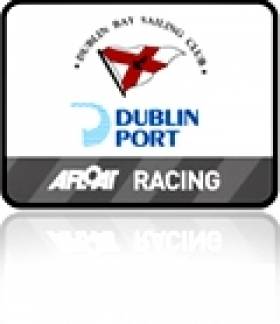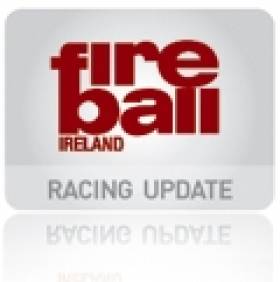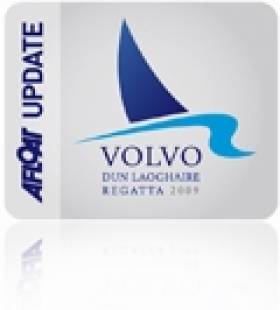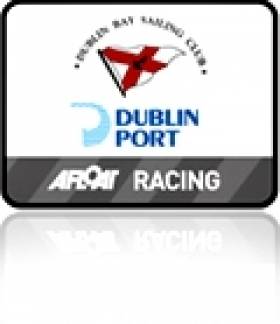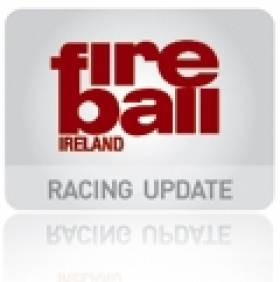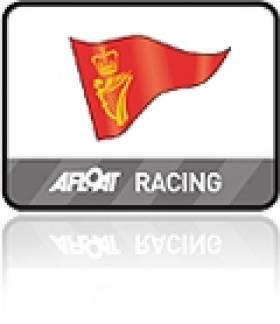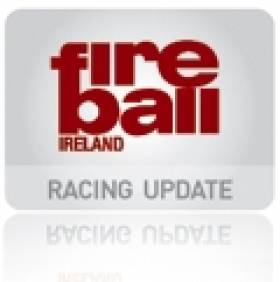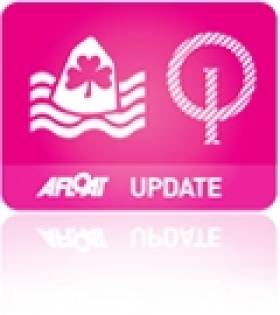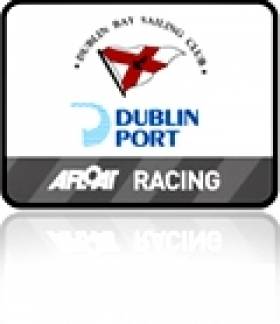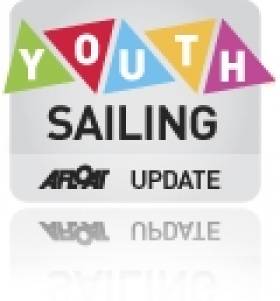Displaying items by tag: Dinghy
Yacht Broker O'Leary Marks Return to DBSC Sailing with a Win
Ross O'Leary marked his return to Dublin Bay Sailing Club (DBSC) racing last night with a light air win in the PY/Laser class. The Dun Laoghaire based yacht broker has missed part of the dinghy season due to an ankle injury. Second home was Gary O'Hare. Full results for both DBSC Dinghy and Cruiser fleets are below:
DUBLIN PORT Dublin Bay Sailing Club Results for 23 AUGUST 2011
BENETEAU 31.7 - 1. Magic (D.O'Sullivan/D.Espey)
BENETEAU 31.7 - 1. Magic (D.O'Sullivan/D.Espey)
CRUISERS 2 - 1. Red Rhum (J Nicholson), 2. Free Spirit (John O'Reilly)
CRUISERS 3 - 1. Asterix (Counihan/Meredith/Bushell), 2. Upd8 (Whelan/McCabe/Carey)
Ensign - 1. NYC 2 (Helen Cooney)
FIREBALL - 1. Goodness Gracious (Louise McKenna), 2. Blind Squirrel (Frank Miller), 3. No Name (B McGuire)
IDRA 14 FOOT - 1. Dart (Pierre Long), 2. Doody (J.Fitzgerald/J.Byrne), 3. Dunmoanin (Frank Hamilton)
MERMAID - 1. Tiller Girl (J.O'Rourke), 2. Jill (P.Smith/P.Mangan), 3. Kim (D Cassidy)
PY CLASS - 1. Ross O'Leary (Laser), 2. Gary O'Hare (Laser), 3. P Keane (Laser 1)
30 Boats Expected for Dun Laoghaire Fireball Dinghy Nationals
An initial review of the commitments and promises to contest the Fireball Nationals, hosted by Dun Laoghaire Motor Yacht Club, over the weekend of 26 – 28 August, conducted last Tuesday night after DBSC racing suggests that a fleet in the mid-thirties is possible.
Of course this means that all those people who have had recent contact with Neil Colin about sailing the event will have to deliver on their promises to be there.
In a year when our sailing programme has had to accommodate a two-week Worlds in Sligo, the prospect of a 30+ fleet is very exciting.
Nine races are programmed for the 3 days and Neil Colin, who is wearing two hats – DMYC representative and Fireball Committee member – appears to have all the organisational boxes ticked. The keelboat fraternity also has an event over the same weekend in Dublin Bay – the Cruiser Challenge.
In the Gold fleet there will as always be a queue of teams looking for the podium places. The three regattas sailed thus far this season have each had different winners – Graeme Grant & Francis Rowan in Carlingford, Noel Butler & Stephen Oram in Dun Laoghaire and Simon McGrotty & Ruari Grimes in Ballyholme. However, there are other combinations who have also featured in the 1-2-3 with Barry McCartin/Conor Kinsella getting onto the podium in two of these regattas, Kenny Rumball & Seamus Moore coming good in Belfast Lough, Francis Rowan & Conor taking the Volvo Dun Laoghaire Regatta, Diana Kissane taking a podium place in Dun Laoghaire as well as Andy Boyle.
In Belfast Lough Messrs Bracken & O'Hara were starting to show a return to the sort of form that made them regular occupiers of podium places in the recent past. Louis Smyth has also been showing a good turn of form as well. Frank Miller/Grattan Donnelly took a race win in Belfast Lough and have shown on Tuesday nights in DBSC racing that when they get the "bit between their teeth" they can be just as competitive as anyone.
The Silver fleet racing has also been very good this year and with new combinations coming into the Class as a consequence of the Worlds, there should be good competition in Dun Laoghaire for these combinations. The two Bens – Malone and Scallan showed their mettle in Sligo with the former also taking the Silver fleet prize in Carlingford. Cearbhall Daly & Martina Michels took over that mantle at the Dun Laoghaire event, while Hannah Showell & Margaret Casey won in Ballyholme. Marie Barry has featured strongly in this year's Silver fleet and will be breaking in a new helm for the Nationals! Mary Chambers & Brenda McGuire have upped their game considerably since they embarked on the Silver Fleet training in Killaloe and Dun Laoghaire in 2010, even going so far as to upgrade their boat to make themselves even more competitive. We have also seen some new talent coming into this fleet since the Worlds – new owners of Kenny Rumball's 14962 - who have confirmed their intention to sail the Nationals.
The challenge to those we have been missing this year is to see how they match up to these new combinations. For a variety of reasons, personal and work-related a number of people have been conspicuous by their absence for the circuit this year and that is understandable. The idea behind a Dublin Bay Nationals this year was to improve the accessibility and cost of the Nationals in a year when most people were expected to spend time in Sligo.
The initial assessment of the entry last Tuesday night would appear to suggest that decision has been vindicated.
The intrepid travellers have come from such places as Limerick and Liverpool. Within the class, Ralph Roberts is a representative of the more adventurous. In the company of a most amazing crewman, Ralph sailed his dinghy from Liverpool to Dun Laoghaire, though he did break the journey with a short respite in Hollyhead.
During the trip, the highfield lever, a mechanism which controls the rig and the ability to sail to windward kept slipping which must have accounted for a considerable portion of his 23 hour journey time. Apparently the troublesome nature of this piece of kit on the boat is on par for the vintage and value of the boat in question. His fellow Wayfarer comrades, on hearing of his difficulties emptied their tool boxes and kindly supplied him with replacement parts. Upon receiving such bounty, he was heard to remark, 'For the return journey, we can now sail around Ireland.'
Apparently, a non stop circumnavigation of the island of Ireland is not beyond the boat's resources as one or other of the helm and crew can be ensconced in sleeping bags and be securely tied-in under the thwart. Indeed this, according to one, is how Ralph planned his accomodation for this Regatta.
This particular boat's name is 'Foxy Lady'. She can be seen swinging on a mooring on the East Bight area of the harbour. She didn't sail today. Perhaps the light airs and the relative short race-course are not enough of a challenge for her? Or maybe her crew are distracted in their perparations for an entry in the Vendee Globe. Well, it stands to reason doesn't it? The Barcelona Double Handed Round the World Race has already started and the next Round Ireland Race is not 'till next year.
The Vendee, being a single-handed only race, should release Ralph's Most Amazing Crew (M.A.C.) for more heroic duties on other boats. Should anyone with to avail of M.A.C's services, we will of course forward your application if it is suitably supported with a description of a similar Ralphesque type adventure.
Strong Winds Confine DBSC Dinghies to Harbour Course
No sooner had the Dublin Bay Sailing Club (DBSC) dinghy fleet sought the refuge of Dun Laoghaire harbour for tonight's racing than the strong southerly winds that swept the bay abated. Racing however continued in the confines of the harbour, the results (below) showing another win for Frank Hamilton's Dunmoanin' in the IDRA 14 foot class. Second was Sapphire sailed by Lorcan O'Sullivan and third was Jenny Byrne's Doody. In the Fireball dinghy class, Stephen Oram's new boat, the top Irish performer in the Sligo World Championships last month, was the winner in that class. Full DUBLIN PORT Dublin Bay Sailing Club Results for 5 JULY 2011 are below:
BENETEAU 31.7 - 1. Extreme Reality (P.McSwiney/E.O'Rafferty), 2. Attitude (D.Owens/T.Milner)
BENETEAU 31.7 - 1. Extreme Reality (P.McSwiney/E.O'Rafferty), 2. Attitude (D.Owens/T.Milner)
CRUISERS 2 - 1. Borraine (Ean Pugh), 2. Cor Baby (Keith Kiernan et al), 3. Free Spirit (John O'Reilly)
CRUISERS 3 - 1. Chouskikou (R.Sheehan/R.Hickey), 2. Papytoo (M.Walsh/F.Guilfoyle), 3. Wynward (Wyn McCormack)
FIREBALL - 1. nn (S Oram), 2. Licence to Thrill (Louis Smyth), 3. Goodness Gracious (Louise McKenna)
IDRA 14 FOOT - 1. Dunmoanin (Frank Hamilton), 2. Sapphire (Lorcan O'Sullivan), 3. Doody (J.Fitzgerald/J.Byrne)
MERMAID - 1. Jill (P.Smith/P.Mangan), 2. Oonagh (J&M Griffith)
PY CLASS - 1. Evan Dolan (), 2. P Keane (Laser 1), 3. C Arrowsmith (Laser)
Fireball World Champs Makes the News
Monday's Fireball World Sailing Championships got a publicity lift last night when the 58–dinghy sailing event bound for Rosses Point in Sligo made the RTE News bulletin. (See clip below). It's an interesting piece about how a local sailing family, the Armstrong's, have built a home-made boat especially for the event.
The spread of countries heading for the northwest covers Ireland, United Kingdom, Switzerland, Australia, Shetland Islands, France, Czech Republic, Canada and Germany, with the continents being Europe, Australia and North America.
The home contingent boasts 28 boats, followed by GBR with 17 boats, France and Switzerland have three entries each, Canada and the Czech Republic 2, with Australia, the Shetlands and Germany each having one. However, there is a late attempt to get a second Australian entry to the event and in fact with entries being open right up to the eve of the regatta, there is always the prospect that more boats may still declare.
Royal Cork Aims for Biggest Ever National 18 Turnout
The Royal Cork YC aims to host the largest ever gathering of National 18's this summer. The 2011 class championship, better known locally as the Cock O' The North, will take place at RCYC in Crosshaven from Sunday 24th to Friday 29th July. In excess of 50 boats are expected to participate. Latest Royal Cork News here.
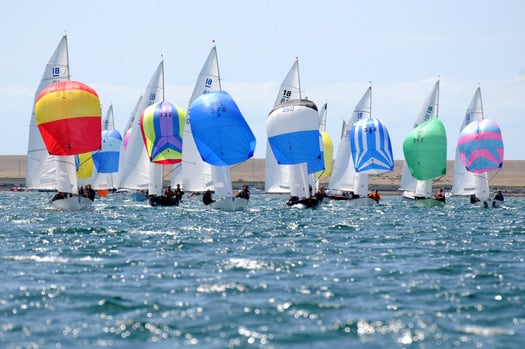
The class has roots all over Ireland and the United Kingdom. Traditionally the event sees entries from Scotland, London, Cork and Isle of Man. While strong numbers will travel as always from those centres, a feature of this year's event is the addition of entries from Lymington, Gloucester, Swansea, Lough Derg, Lough Neagh, Waterford, Schull, Ballydehob and Baltimore.
The event will cater for all National 18s whether old or new. The fleet will have three distinct divisions at this year's championships. The modern fleet will be known as Ultimate's, with the older fibreglass boats going into the Penultimate division while the original wooden clinker boats will race in the Classic division.
At the front of the ultimate fleet the competition will be intense with Anthony Ellis and crew from the Isle of Man doing their best to retain the crown that they won on home waters last season. However they will face a huge challenge with the likes of Colin Chapman, Nick Walsh and Tom Crosbie from the host club as well as the Barry brothers, Colin and Ewen from Monkstown Bay.
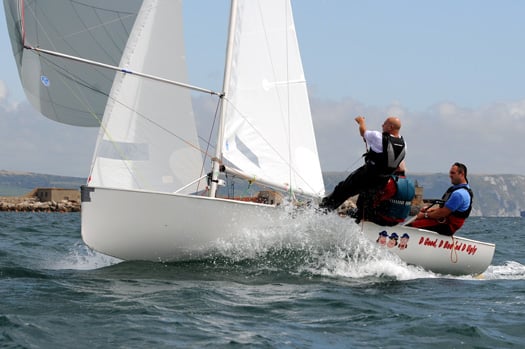
In the penultimate's class the fleet is seeing many older fibreglass boats being refurbished and brought out for the event. Expect to see Willie Healy on 'Break Even' and Grattan Roberts on 'Manniken P' feature strongly.
While the intention among the classics is that racing will not be as intense this division expects to see approximately ten boats from both home and abroad. Wolfgang Felder is travelling from Germany to participate alongside well known Cork sailors like Dick Gibson, Dan Cross and Tom Kirby. An interesting piece of history is that John Murphy of Baltimore SC will race in 'Tornado' which was the first winner of the Cock O'The North back in 1952.
Many former 18 sailors are making their way back to the class in recent times. The likes of John Crotty, Patsy O'Mahony and Bobby Kerr are expected to make it to the start line for this season to add a further element of experience to the fleet.
Among the many trophies to be raced for will be two trophies originally won by the late Richard Lane in Doldrum at the 1961 Championships sailed at Mumbles. The Lane family has kindly donated the trophies to the class and they will be raced for 50 years after Doldrum swept the board at the Welsh venue. While there has been no 18 activity at Mumbles in recent years it is expected that a crew from the club will race this year after the launch of a new pilot project by the class to stimulate 18 sailing in Wales.
Another interesting note to this event is the recent approval of carbon fibre masts and with up to 20% of the fleet already having switched over, eyes will be focused on any improved performance.
Like any good sailing event as much effort has been put into the social aspect. A full week's social programme has been planned ranging from a Christmas party to the Class Dinner. The Class Dinner will also serve as a reunion for former 18 sailors and it is expected that 300 people will attend what will be an historic occasion. All this sailing and socialising is thirsty work and so the class has commissioned a special beer for the week to be known as 'Cock a Doodle Brew' to mark the event.
For more information on the event go to www.national18.com.
Next month's Fireball World Championships at Sligo Yacht Club has announced Irish boating shoe manufacturer Dubarry as title sponsor. The event is expected to attract up to 100 boats from 13 countries. Dun Laoghaire's Noel Butler is expected to lead the home fleet but already new boats are on the scene and doing well at the Fireball stronghold on Dublin Bay. The international jury has been named for the two week event as: Krystyna Lastowska International race officer from Poland, Pam Johnson International Measurer from Great Britain, Tim Went from Australia, Brendan Brogan from Ireland, Keld Stentoft from Denmark, Francois Schluchter from Switzerland, Johan Devocht from Belgium. Click for the latest Fireball news.
More on the Fireball class on the forum here.
Irish Optimists Finish Top in Braassemeer
Moth Dinghy Makes its Dublin Bay Sailing Club Debut
Making its debut for the first time under the club burgee was an International Moth dinghy. The ultra fast hull was airborne at just eight knots of breeze, making even the trapezing Fireballs look slow. But despite the pace the new fangled dinghy did not feature in the overall Portsmouth Yardstick (PY) results. See below.
A healthy turnout of six 'balls, urged on by the fact that the class World Championships is in Sligo in 46 days time, got some trapezing gusts and some planing waves downwind in a north-easterly breeze of 6-8 knots. S. Oram took the winning gun from Louis Smyth sailing Licence to Thrill.
Single handed Lasers boasted twice the Fireball turnout to be the biggest class racing in Scotsman's bay tonight. It's a show of strength from a class surely worthy of its own start if this kind of turnout can be maintained.
Sean Craig won the Laser race from Peter Craig but the overall PY result went to E. Ryan's RS400.
Two Dublin Bay Mermaids and disappointingly, a single IDRA 14, No.124, Squalls also competed.
DUBLIN PORT Dublin Bay Sailing Club Results for 26 APRIL 2011
FIREBALL - 1. nn (S Oram), 2. Licence to Thrill (Louis Smyth), 3. Incubus (C Power/M Barry)
MERMAID - 1. Lively Lady (G O'Neill & M Hanney), 2. Jill (P.Smith/P.Mangan)
PY CLASS - 1. E Ryan (RS400), 2. Sean Craig (Laser), 3. Peter Craig (Laser)
BENETEAU 31.7 - 1. Extreme Reality (P.McSwiney/E.O'Rafferty), 2. Magic (D.O'Sullivan/D.Espey)
BENETEAU 31.7 - 1. Magic (D.O'Sullivan/D.Espey), 2. Extreme Reality (P.McSwiney/E.O'Rafferty)
CRUISERS 2 - 1. Cor Baby (Keith Kiernan et al), 2. Red Rhum (J Nicholson), 3. Free Spirit (John O'Reilly)
CRUISERS 3 - 1. Grasshopper 2 (K & J Glynn), 2. Pamafe (Michael Costello), 3. Papytoo (M.Walsh/F.Guilfoyle)
CRUISERS 4 - 1. Maranda (Myles Kelly), 2. Ghrazel (Charles Pearson), 3. Artemis (J.Giles)
RUFFIAN 23 - 1. Diane ll (Bruce Carswell), 2. Icicle (C & J Murray), 3. Alias (D.Meeke/M.McCarthy)
SIGMA 33 - 1. Rupert (R.Lovegrove/P.Varian), 2. Pippa lV (G.Kinsman/K.Blake/M.O'Brien)
SQUIB - 1. Tais (Michael O'Connell), 2. Periguin (N.Coakley/J.Redahan)
More DBSC News here.
Dinghy Sailor Finn Lynch Wins Laser 4.7 Prize
Irish youth sailing sensation Finn Lynch has won the Laser 4.7 prize sailing in Lake Garda in Italy this month, the win was recorded at his first international event since moving to the Laser class. Lynch from the National Yacht Club came tenth overall in a fleet of 230 competitive boats. Lynch, from Blessington, is reigning UK and Irish Topper Champion. He also finished second in the Topper worlds championships last season before moving to the Laser class.
Lynch's Dun Laoghaire club mate Tadgh Donnelly followed closely as seventh U16 sailor and 54th overall. In the Radials Rory Lynch and Philip Doran both finished in the top third of a fleet of 220 boats with some very good races during the event.
Podcast on youth sailing with Olympic team manager James O'Callaghan.


























